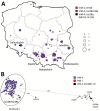Genome-Based Epidemiologic Analysis of VIM/IMP Carbapenemase-Producing Enterobacter spp., Poland
- PMID: 37486192
- PMCID: PMC10370858
- DOI: 10.3201/eid2908.230199
Genome-Based Epidemiologic Analysis of VIM/IMP Carbapenemase-Producing Enterobacter spp., Poland
Abstract
We sequenced all nonduplicate 934 VIM/IMP carbapenemase-producing Enterobacterales (CPE) reported in Poland during 2006-2019 and found ≈40% of the isolates (n = 375) were Enterobacter spp. During the study period, incidence of those bacteria gradually grew in nearly the entire country. The major factor affecting the increase was clonal spread of several E. hormaechei lineages responsible for multiregional and interregional outbreaks (≈64% of all isolates), representing mainly the pandemic sequence type (ST) 90 or the internationally rare ST89 and ST121 clones. Three main VIM-encoding integron types efficiently disseminated across the clone variants (subclones) with various molecular platforms. Those variants were predominantly Pseudomonas aeruginosa-derived In238-like elements, present with IncHI2+HI2A, IncFII+FIA, IncFIB, or IncN3 plasmids, or chromosomal genomic islands in 30 Enterobacter STs. Another prevalent type, found in 34 STs, were In916-like elements, spreading in Europe recently with a lineage of IncA-like plasmids.
Keywords: E. hormaechei; Enterobacter; Enterobacterales; Poland; ST89; ST90; VIM; antimicrobial resistance; bacteria.
Figures


References
-
- Centers for Disease Control and Prevention. Antibiotic resistance threats in the United States, 2019. [cited 2023 Apr 24]. https://www.cdc.gov/drugresistance/pdf/threats-report/2019-ar-threats-re...
-
- Papagiannitsis CC, Izdebski R, Baraniak A, Fiett J, Herda M, Hrabák J, et al.; MOSAR WP2, WP3 and WP5 study groups; MOSAR WP2 WP3 and WP5 study groups. Survey of metallo-β-lactamase-producing Enterobacteriaceae colonizing patients in European ICUs and rehabilitation units, 2008-11. J Antimicrob Chemother. 2015;70:1981–8. 10.1093/jac/dkv055 - DOI - PubMed
Publication types
MeSH terms
Substances
LinkOut - more resources
Full Text Sources
Research Materials
Miscellaneous

